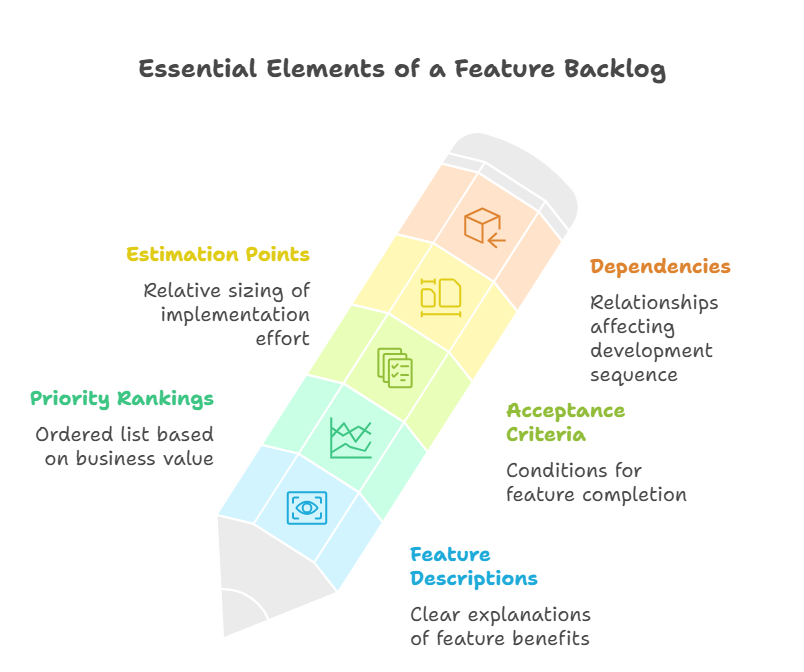What Is a Feature Backlog? A Guide for Product Teams
Learn what a feature backlog is, how it differs from product backlog, and best practices for managing and prioritizing features effectively.
What Is a Feature Backlog?
A feature backlog is a prioritized inventory of new features, enhancements, and improvements that a product team plans to develop. It serves as the tactical execution layer that translates strategic product vision into actionable development work. While often used interchangeably with product backlog, the feature backlog specifically focuses on customer-facing functionality rather than the broader scope of technical debt, bugs, and infrastructure work.
In agile development frameworks, the feature backlog represents the bridge between high-level strategic planning and day-to-day development tasks. As Productboard explains, it contains "new features, bug fixes, improvements, changes to existing features, and other product initiatives" that teams must prioritize and deliver to bring a product to life strategically.
Feature Backlog vs Product Backlog
Understanding the distinction between feature backlog and product backlog is crucial for effective product management. While these terms are often used interchangeably, they serve different purposes in the product development hierarchy.
The product backlog is the comprehensive master list containing all potential work items, including features, technical debt, bug fixes, and infrastructure improvements. As Aha.io defines it, it's "a prioritized inventory of new features and other enhancements" that represents everything the team might work on.
The feature backlog specifically focuses on customer-facing functionality and represents a subset of the product backlog. According to Microsoft's Azure DevOps documentation, features typically sit between epics and user stories in the work item hierarchy, organizing related backlog items around specific customer value propositions.
Key Components of a Feature Backlog
A well-structured feature backlog contains several essential elements that ensure clarity and effective execution across the product team.

- Feature descriptions: Clear, concise explanations of what each feature will deliver to users
- Priority rankings: Ordered list indicating which features should be developed first based on business value and user impact
- Acceptance criteria: Specific conditions that must be met for a feature to be considered complete
- Estimation points: Relative sizing of effort required for implementation
- Dependencies: Relationships between features that affect development sequencing
As Asana notes, a product backlog is "an ordered list of tasks, features, or items to be completed as part of a larger product roadmap," and the same principles apply to feature backlogs specifically.
Best Practices for Managing Your Feature Backlog
Effective feature backlog management requires consistent attention and strategic thinking. These practices help maintain a healthy, actionable backlog that drives product success.
Regular Prioritization and Refinement
The most critical aspect of backlog management is maintaining proper prioritization. The backlog should be a living document that evolves based on changing market conditions, user feedback, and business priorities. Regular backlog grooming sessions ensure that the team always works on the most valuable features next.
Clear Definition and Scope
Each feature in the backlog should have a well-defined scope and clear acceptance criteria. This prevents scope creep and ensures that developers understand exactly what needs to be built. Features should be broken down into manageable pieces that can be completed within a single development cycle when possible.
Strategic Alignment
Every feature should clearly connect to broader product strategy and business objectives. As highlighted in Reddit discussions about product backlogs, a backlog represents "improvements, features and defects that a product team needs to complete over a period of time" to achieve strategic goals.
Visualizing Your Feature Backlog with Mind Maps
For product managers and teams struggling to maintain clarity across complex feature backlogs, visual tools can transform how you organize and prioritize work. Mind mapping provides an intuitive way to see relationships between features, identify dependencies, and communicate priorities across stakeholders.
At ClipMind, we've found that converting feature backlogs into visual mind maps helps teams spot opportunities for batching related work and identifying potential bottlenecks early. The visual nature of mind maps makes it easier to explain prioritization decisions to non-technical stakeholders and ensure everyone understands how individual features contribute to the bigger picture.
If you're looking to bring more clarity to your feature planning process, try our AI Outline Maker to structure your backlog items or use our Project Planner to organize features within broader development initiatives.
Maintaining a Healthy Feature Backlog
A well-maintained feature backlog is neither too long nor too short. It should contain enough validated ideas to keep the development team productive while avoiding the paralysis that comes from overwhelming choice. Regular pruning of low-value features and consolidation of similar items keeps the backlog manageable and focused.
Remember that the feature backlog is a tool for execution, not a wish list. Every item should be something the team realistically expects to build within the foreseeable future. By maintaining this discipline, product teams can ensure their feature backlogs remain actionable instruments that drive meaningful product evolution rather than becoming digital graveyards for good ideas that never quite made the cut.
 ClipMind
ClipMind